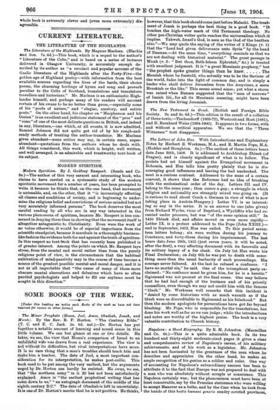The Letters of John Hits. With Introductions and Explanatory Notes
by Herbert B. Workman, M.A., and R. Martin Pope, M.A. (Hodder and Stoughton. 6s.)—The earliest of these letters bears date June 30th, 1408. It is addressed to Archbishop Zbinek (of Prague), and is clearly significant of what is to follow. The prelate had set himself against the Evangelical movement in Bohemia, and Has tells him pretty plainly that he is dis- couraging good influences and leaving the bad unchecked. The next is a curious contrast. Addressed to the nuns of a certain convent, it shows that the Reformer had no idea of breaking with the ecclesiastical order of the day. Letters III. and IV. belong to the same year ; then comes a gap ; a struggle in which religion and nationality are strangely mixed was going on. (It is curious to read about Czech v. German in view of what is now taking place in Austria-Hungary.) Letter VI. is as interest- ing as any in the series. It is an answer to one (also given) from Richard Wyche, vicar of Deptford, a Wycliffite who had re- canted under pressure, but was "of the same opinion still." In 1410 Zbinek died, and affairs moved on even more rapidly— Letter IX. is a protest addressed to the Pope (John XXIII.)— and in September, 1412, Hue was exiled. To this period seven- teen letters belong ; six were written during his journey to Constance, and forty-three during his imprisonment. The last bears date June 29th, 1415 (just seven years, it will be noted, after the first), a very affecting document with its farewells and its solitary legacy of a fur cloak. On July 1st Has wrote his Final Declaration ; on July 6th he was put to death with some- thing more than the usual barbarity of such proceedings. His courage never faltered. At the last he refused a confessor. "I have no mortal sin," he said. One of the triumphant party ex- claimed: "No confessor must be given him, for he is a heretic." Sigismund was not present at the final scene. One may believe that he had had enough of the business and of his priestly counsellors, even though we may not credit him with the famous "blush." Mr. Workman well remarks that this incident is "denied by some historians with as much warmth as if the blush were as discreditable to Sigismund as his falsehood." But then the modern apologists for persecutions have got far beyond blushing. Mr. Pope, who is responsible for the translations, has done his work well as far as we can judge ; while the introductions and notes are worthy of the highest praise. The book is a very valuable contribution to Church history.






































 Previous page
Previous page